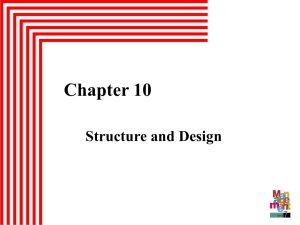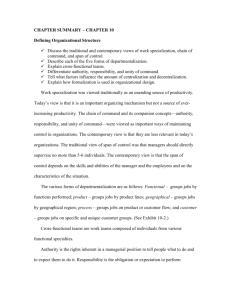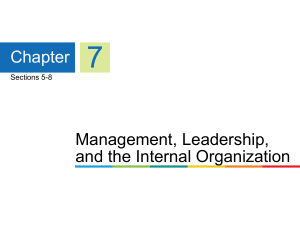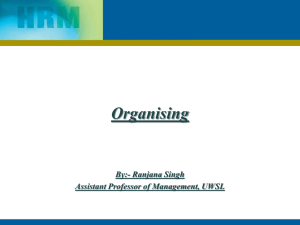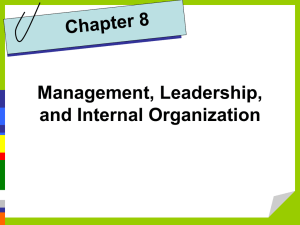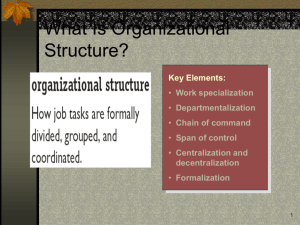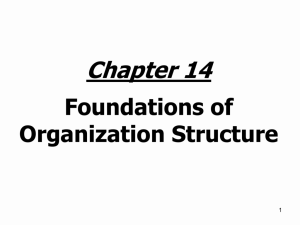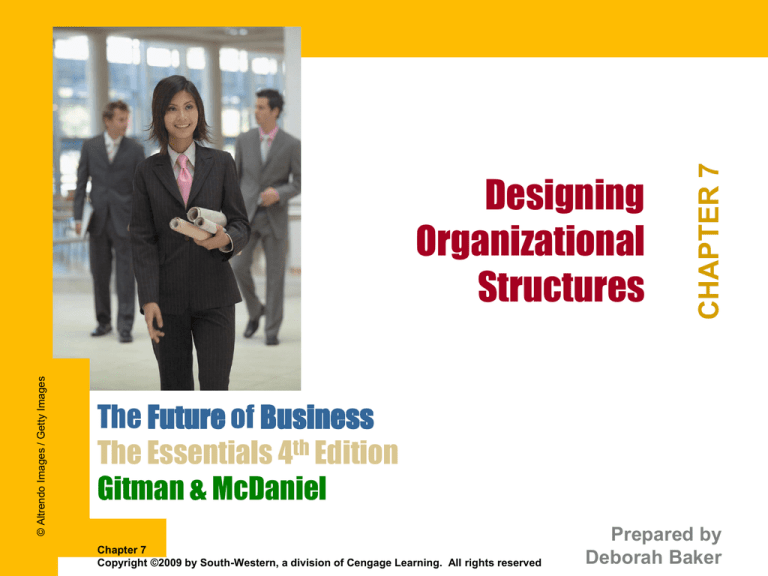
© Altrendo Images / Getty Images
CHAPTER 7
Designing
Organizational
Structures
The Future of Business
The Essentials 4th Edition
Gitman & McDaniel
Chapter 7
Copyright ©2009 by South-Western, a division of Cengage Learning. All rights reserved
Prepared by
Deborah Baker
CHAPTER 7
Learning Goals
1 What are the five traditional forms of
departmentalization?
2 What contemporary organizational structures
are companies using?
3 Why are companies using team-based
organizational structures?
4 What tools do companies use to establish
relationships within their organizations?
2
CHAPTER 7
Learning Goals (continued)
5 How can the degree of centralization/
decentralization be altered to make an
organization more successful?
6 How do mechanistic and organic organizations
differ?
7 How does the informal organization affect the
performance of the company?
8 What trends are influencing the way
businesses organize?
3
Departmentalization
1
1
What are the five traditional forms of
departmentalization?
4
The Organizing Process
Determining work
activities and
dividing up tasks
1
(division of labor)
Grouping jobs and
employees
(departmentalization)
Assigning authority
and responsibilities
(delegation)
5
Departmentalization
formal organization
The order and design of relationships with a firm;
consists of two or more people working together
with a common objective and clarity of purpose.
1
6
Division of Labor
division of labor
The process of dividing work into separate jobs
and assigning tasks to workers.
specialization
The degree to which tasks are subdivided into
smaller jobs.
1
7
Departmentalization
departmentalization
The process of grouping jobs together so that
similar or associated tasks and activities can be
coordinated.
1
8
Organization Chart
President
Vice-Presidents
Finance
Manager,
accounting
1
Manager,
allocations &
inventory control
Operations
Production
manager
Manager,
financial
planning
Marketing
Sales
manager
Director
of human
resources
Distribution
manager
Director
of customer
service
9
Basic Types of Departmentalization
1
Functional
Based on the primary
functions performed
Product
Based on the goods/services
produced or sold
Process
Based on the production
process used
Customer
Based on the primary type of
customer served
Geographic
Based on the geographic
segmentation of organizational units
10
Functional Departmentalization
President
Legal
1
Personnel
Manufacturing
Engineering
Exhibit 7.2
Marketing
Finance
11
Product Departmentalization
Administrator
and CEO
Head of
outpatient /
emergency
1
Head of
pediatrics
Head of
cardiology
Exhibit 7.2
Head of
orthopedics
Head of
obstetrics /
gynecology
12
Process Departmentalization
Plant
superintendent
Lumber cutting
and
treatment
1
Furniture
assembly
Furniture
finishing
Exhibit 7.2
Shipping
13
Customer Departmentalization
Vice president,
marketing
Marketing manager,
railroad customers
1
Marketing manager,
aircraft customers
Marketing manager,
automotive
customers
Exhibit 7.2
Marketing manager,
military customers
14
Geographic Departmentalization
Vice president,
marketing
Director,
U.S. and Canadian
marketing
1
Director,
European
marketing
Exhibit 7.2
Director,
South American
marketing
15
Line-and-Staff Organization
Line functions
President
Corporate
attorney
Vice president
of marketing
Marketing
research
specialist
Sales
manager
1
Sales
manager
Assistant to
president
Vice president
of manufacturing
Vice president
of finance
Qualitycontrol
engineer
Advertising
specialist
Sales
manager
Staff functions
Supervisor
Supervisor
Exhibit 7.3
Supervisor
Internal
auditor
Cost
accountant
Credit
analyst
16
CONCEPT check
How does specialization lead to greater
efficiency and consistency in production?
What are the five types of departmentalization?
1
17
Contemporary Structures
2
2
What contemporary organizational
structures are companies using?
18
Contemporary Structures
Matrix Structure
Committee Structure
2
19
Contemporary Structures
matrix structure
An organizational structure that combines
functional and product departmentalization by
bringing together people from different
functional areas to work on a special project.
2
20
Matrix Structure
Advantages
2
Disadvantages
Teamwork
Power struggles
Efficient use of
resources
Confusion among
team members
Flexibility
Lack of cohesiveness
Ability to balance
conflicting objectives
Higher performance
Opportunities for
development
21
Matrix Structure
2
22
Exhibit 7.4
Contemporary Structures
committee structure
An organizational structure in which authority
and responsibility are held by a group rather
than an individual.
2
23
Committee Structure
Advantages
2
Coordination of tasks
is easier
Bring diverse
viewpoints to a problem
Expand possible
solutions
Disadvantages
Slow to reach decisions
Sometimes dominated
by a single individual
Difficult to hold
individuals accountable
Meetings seem slow
and unproductive
24
CONCEPT check
Why does the matrix structure have a dual
chain of command?
How does a matrix structure increase power
struggles or reduce accountability?
What are advantages of a committee structure?
Disadvantages?
2
25
Using Teams
3
3
Why are companies using team-based
organizational structures?
26
Group Behavior
Formal
Informal
3
Organizational strategy
Company policies and procedures
Available resources
Corporate culture
Member characteristics
Roles and norms of group members
Size and cohesiveness of group
27
Group Behavior
group cohesiveness
The degree to which group members want to
stay in the group and tend to resist outside
influences.
Increases when:
• the size of the group is small
• goals are congruent
• group has high status
• rewards are group based
• group competes with other groups
3
28
Group Decision Making
Strengths
3
Groups bring more information and knowledge
Groups offer a diversity of perspectives and a
greater number of alternatives
Results in a higher-quality decision
Participation increases likelihood of decision
acceptance
29
Group Decision Making
Weaknesses
3
Groups take a longer time to reach a solution
Group members may pressure others to
conform
The process may be dominated by one or a
small number of participants
Groups lack accountability
30
Work Groups versus Work Teams
work groups
Share resources and coordinate efforts to help
members better perform individual duties and
responsibilities.
work teams
Require coordination and collaboration. Requires
the pooling of knowledge, skills, abilities, and
resources to achieve a common goal.
A work team creates synergy, causing the
performance of a team to be greater than the sum of
individual contributions.
3
31
Building High-Performance Teams
Employees willing to work together
Members possess a variety of skills
Teams have clearly defined goals
Teams practice good communication
Great teams have great leaders
3
32
Team Leaders
3
Divide up work so that tasks are not repeated
Help members set and track goals
Monitor their team’s performance
Communicate openly
Remain flexible
33
CONCEPT check
What is the difference between a work team
and a work group?
Identify and describe three types of work
teams.
What are some ways to build a highperformance team?
3
34
Authority—
Establishing Organizational Relationships
4
4
What tools do companies use to establish
relationships within their organizations?
35
Managerial Hierarchy
managerial hierarchy
The levels of management within an organization;
typically, includes top, middle, and supervisory
management.
4
36
Managerial Hierarchy
authority
Legitimate power, granted by the organization and
acknowledged by employees, that allows an
individual to request action and expect compliance.
delegation of authority
The assignment of some degree of authority and
responsibility to persons lower in the chain of
command.
4
37
Span of Control
span of control
The number of employees a manager directly
supervises; also called span of management.
4
38
Chain of Command
chain of command
The line of authority that extends from one level of
an organization’s hierarchy to the next, from top
to bottom, and makes clear who reports to whom.
4
39
Narrow Span of Control
Advantages
Higher degree of
control
More management
levels, more expensive
Manager is more
familiar with
individuals
Slower decision making
Isolation of top
management
Close supervision can
provide immediate
feedback
Discourages employee
autonomy
4
Disadvantages
40
Wide Span of Control
Advantages
4
Increased efficiency
and reduced costs
Quicker decision
making
Greater flexibility
Higher levels of job
satisfaction
Disadvantages
Less control
Possible lack of
familiarity
Managers spread thin
Lack of coordination
or synchronization
41
Optimal Span of Control
Factors Determining Optimal Span of Control
1.
2.
3.
4.
5.
4
Nature of task
Location of workers
Ability of manager to delegate responsibility
Interaction and feedback between workers and manager
Level of skill and motivation of workers
42
CONCEPT check
How does the chain of command clarify reporting
relationships?
What is the role of a staff position in a line-and-staff
organization?
What factors determine the optimal span of control?
4
43
Degree of Centralization
5
5
How can the degree of centralization/
decentralization be altered to make an
organization more successful?
44
Degree of Centralization
centralization
The degree to which formal authority is
concentrated in one area or level of an
organization.
decentralization
The process of pushing decision-making authority
down the organizational hierarchy.
5
45
Degree of Centralization
Centralization
5
Top management makes most key decisions
Managers have broad view of operations and
exercise tight financial controls
Reduces costs by eliminating redundancy
Lower level personnel don’t get leadership
opportunities
Organization is less responsive to customer
demands
46
Degree of Centralization
Decentralization
5
Quicker decision making
Increased levels of innovation and creativity
Greater organizational flexibility
Faster development of lower-level managers
Increased job satisfaction and employee commitment
Lower-level personnel may make costly mistakes
Increases likelihood of inefficient communication,
competing objectives, and duplication of effort
47
Factors Influencing Decision-Making Authority
Size of the organization
Speed of change in environment
Managers’ willingness to give up authority
Employees’ willingness to accept more authority
Organization’s geographic dispersion
5
48
Degree of Centralization
Decentralization is desirable when…
Organization is very large
Firm is in a dynamic environment
where quick decisions must be made
Managers are willing to share
power with subordinates
Employees are willing and able
to take more responsibility
5
Company is spread out
geographically
49
CONCEPT check
What are the characteristics of a centralized
organization?
What are the benefits of a decentralized
organization?
What factors should be considered when choosing
the degree of centralization?
5
50
Organizational Design Considerations
6
6
How do mechanistic and organic
organizations differ?
51
Organizational Design Considerations
Mechanistic Organization
6
Relatively high degree of job specialization
Rigid departmentalization
Many layers of management
Narrow spans of control
Centralized decision making
Long chain of command
Tall organizational structure
52
Organizational Design Considerations
Organic Organization
6
Relatively low degree of job specialization
Loose departmentalization
Few layers of management
Wide spans of control
Decentralized decision making
Short chain of command
Flat organizational structure
53
Mechanistic versus Organic Structures
Firm’s overall strategy
Size of the organization
Stability of its external environment
6
54
CONCEPT check
Compare and contrast mechanistic and organic
organizations.
What factors determine whether an organization
should be mechanistic or organic?
6
55
The Informal Organization
7
7
How does the informal organization affect the
performance of the company?
56
The Informal Organization
Functions of the Informal Organization
Provides a source of friendships and social contact
for organization members
Helps employees feel better informed about and
connected with what is going on
Provides status and recognition not available from
the formal organization
Aids the socialization of new employees
Helps employees to be more aware of what is happening
in the workplace
7
57
CONCEPT check
What is the informal organization?
How can informal channels of communication be
used to improve operational efficiency?
7
58
Trends in Organizational Structure
8
8
What trends are influencing the way businesses
organize?
59
Reengineering
Organizational Structure
reengineering
The complete redesign of business structures and
processes in order to improve operations.
“Starting over”
“If we were a new company, how would we run
this place?”
8
60
Attributes of a Virtual Corporation
Technology
Opportunism
Excellence
Trust
No borders
8
61
Keeping a Virtual Team on Track
Make conversations more personal to build
relationships
Be attuned to the mood and nuances of virtual meetings
Keep staff engaged and focused
Establish one-on-one time with each team member
8
62
Reasons for Outsourcing
Cost reduction
Labor needs
8
63
Steps for Outsourcing Success
8
Identify a specific business problem
Consider all possible solutions
Decide if sending work offshore is the appropriate
answer
Look for offshore providers with high-caliber
systems in place
Find an offshore provider that understands their
business
64
CONCEPT check
How does technology enable firms to organize as
virtual corporations?
What are some organizational issues that must be
addressed when two large firms merge?
8
65


